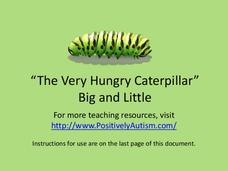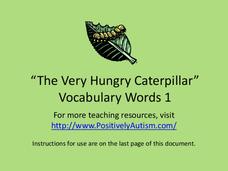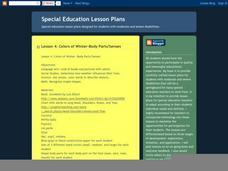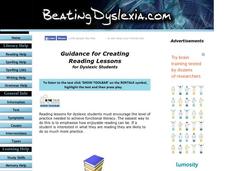Curated OER
Advanced Introduction to TI-8x Calculators: Programming in TI-Basic
Students program a TI-Basic calculator. In this calculator programming lesson, students explore how to create and graph a linear equation. Students study how to input variables into the function and read the graph output.
University of Oklahoma
Understanding My Individualized Education Program
The final unit the series helps learners become familiar with the major components and vocabulary in their IEPs. Using a KWL chart, class members record information about their IEPs and set goals for themselves.
Curated OER
Opening a Special Ed Class
This is not just a lesson plan, it's a life saver! Here are 10 separate documents intended to assist a new Special Ed teacher. There are 4 different games, instructional tips, ways to handle documentation, behavioral modification...
Curated OER
Lesson 6: Mittens, Socks, Mittens, Socks, Mittens!
Mittens and socks, two of my favorite clothing items! Young learners with special needs, explore clothing appropriate for cold weather. They identify both socks and mittens, discuss weather appropriate clothing, and listen to the...
Down Syndrome Possibilities
Down Syndrome: Lesson Plan
You don't usually find lessons written just for learners with Down syndrome, so this is a true jewel. Kindergartners will explore farm animal sounds and identification as they sing the song, "Down on Grandpa's Farm." They sing the song,...
Perkins School for the Blind
Creating a 3-D Model of a Plant Life
Instructing blind or visually impaired learners means you need to make symbolic tactile representations of various processes to provide as much input as possible. But wouldn't it be even better to have your learners make the models...
Positively Autism
The Very Hungry Caterpillar Big and Little Activity
A big caterpillar, a little caterpillar. A big butterfly, a little butterfly. Images from Eric Carle's The Very Hungry Caterpillar model for learners with autism the difference between big and little.
Positively Autism
The Very Hungry Caterpillar Vocabulary
Moon, eggs, leaf, sun, caterpillar. Prior to reading Eric Carle's classic tale, introduce vocabulary for The Very Hungry Caterpillar with these picture cards that also include the vocabulary word printed in large type.
Positively Autism
Knights and Castles Boy/Girl Sort
Learners with autism examine a series of cards with drawings and photographs of knights and ladies, and then sort the images onto printed pages labeled "boys" and "girls." All the figures are dressed in courtly attire.
Curated OER
Learning Through Autobiographical Situations
A special education classroom examines a variety of literature from Latin American authors. In groups, they read excerpts from many autobiographies and compare them with their own life. After writing their own autobiographies, they...
Curated OER
Using Poetry in Teaching Reading to Special Education Students
A series of well-written activities, these lessons prompt middle schoolers reading below grade level (at a second, third, or fourth grade level) to use poetry to practice basic reading skills. They rhyme, build words, make inferences,...
Curated OER
Connecting Letters and Memory
Elementary students with mild to moderate mental disabilities use a variety of tools to connect letter sounds to images. They use flash cards, posters, and writing while saying to connect letter image to phonemic equivalent. Then, they...
Curated OER
History of Ponce de Leon in Florida
Based in sound Educational Theory, this activity uses art to convey the story of Ponce de Leon. Mild to moderately disabled students hear the story of the Fountain of Youth, examine a paining of Ponce de Leon, and act out a scene as...
Curated OER
Fun Activity for Young Children with Autism
Stimulate the senses with this fun activity for young children with Autism. The class makes sensory bottles to use during breaks, down time, or sensory time. They fill the bottles with water, beads, string, glitter, and food coloring,...
Curated OER
Lessons for Young Children with Autism
Here are a variety of lessons geared for young children with Autism. There are 12 short activities intended to build attention, imitation, communication, independent living, social, motor, and literacy skills. Each skill is geared toward...
Curated OER
Colors of Winter-Body Parts/Senses
Fun is in the air as learners with special needs engage in sensory-filled activities. They discuss color, snow, cold, winter, and body parts while touching and smelling various objects. They discuss the parts of the body with relation to...
Curated OER
Lesson 5- Symme "trees": Understanding Same
Pairs of socks can be the same and they can be different. Use socks to emphasise the meanings of the words same and different. Your special ed class will examine each pair of socks you provide to determine if they are the same or...
Curated OER
Big and Small
Sorting big and small objects builds spacial reasoning classification, and visual discrimination skills. Your class will read a story about big and small bubbles, practice identifying big and small objects, then sort big and small balls...
Curated OER
Falling into Shapes
Children with special needs participate in several activities to reinforce shape and color recognition. They sign the word leaf, sing a song about leaves, and bounce leaves around on a parachute. They then help the instructor name...
Curated OER
Lesson 2: Shapes
Shapes are really neat, and here's a instructional activity that will help learners identify shapes through song, touch, and sight. They sing a shape song as they bounce different shapes around in a parachute. They then read a story and...
Curated OER
Guidance for Creating Reading Lessons for Dyslexic Students
Here are a few practical tips and sound strategies you can use in writing effective reading lessons for your pupil with dyslexia. The resource provides simple guidelines and accommodations that can be incorporated into any lesson that...
Curated OER
Guidance for Creating Writing Lessons for Dyslexic Students
How do you help a child with dyslexia succeed as a writer? Here is a resource for those who need guidance in creating writing lessons for their learners with dyslexia. It discusses research-based strategies that can be used and...
Curated OER
How to Improve Eye Tracking to Make Reading Easier
Children with dyslexia may have issues with their eye tracking ability and this may cause problems when they read. Here is a set of three easy steps you can use to improve a learner's eye tracking. The idea is that some kids need help in...
Curated OER
Phonics Help: The Phonic Alphabetic Code Chart
Phonics is a fundamental key to reading success. To help your learners with dyslexia or learning disabilities, try using the phonic alphabetic code chart. The chart and full instructions on how it can be used in the classroom are...























